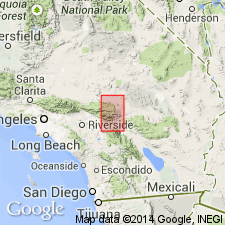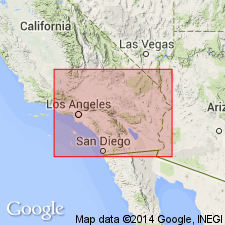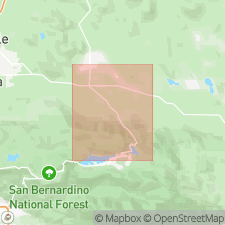
- Usage in publication:
-
- Arrastre quartzite
- Modifications:
-
- Original reference
- Dominant lithology:
-
- Quartzite
- Schist
- AAPG geologic province:
-
- Mojave basin
Summary:
p. 344, 351, 353-365, map. Arrastre quartzite. The oldest sedimetaries positively identified as such in the region. Quartzites and quartzose schists, chiefly thin-bedded, in beds less than 6 inches thick. Differs from Saragossa quartzite in that it contains no beds up to 5 and 10 feet thick of pure quartzite, no pure saccharoidal quartzite, no coarse angular grits, pebble conglomerate, or cross bedding. No fossils found. Grades into Furnace limestone above. Floor on which it was laid down has been destroyed by granite intrusions. Age is probably Early Cambrian.
Named from Arrastre Creek, San Bernadino Co., southern CA.
Source: US geologic names lexicon (USGS Bull. 896, p. 77).

- Usage in publication:
-
- Arrastre complex
- Modifications:
-
- Revised
- AAPG geologic province:
-
- Mojave basin
Summary:
Pg. 471-472. Because Arrastre quartzite is closely involved with much granitic material, it might be better to call combination Arrastre complex. [Age is] younger than Cambrian, probably about middle Paleozoic.
Source: US geologic names lexicon (USGS Bull. 1200, p. 142).

- Usage in publication:
-
- Arrastre Quartzite
- Modifications:
-
- Not used
Summary:
Pg. 1. Arrastre Quartzite of Vaughan (1922). Rocks included in Saragossa Quartzite.
Source: Publication.
For more information, please contact Nancy Stamm, Geologic Names Committee Secretary.
Asterisk (*) indicates published by U.S. Geological Survey authors.
"No current usage" (†) implies that a name has been abandoned or has fallen into disuse. Former usage and, if known, replacement name given in parentheses ( ).
Slash (/) indicates name conflicts with nomenclatural guidelines (CSN, 1933; ACSN, 1961, 1970; NACSN, 1983, 2005, 2021). May be explained within brackets ([ ]).

